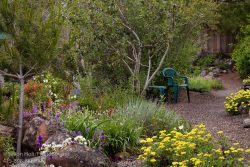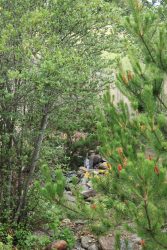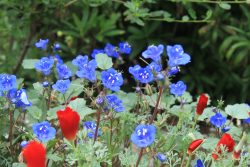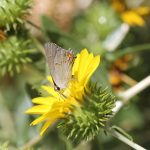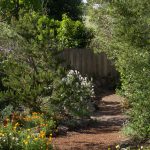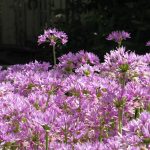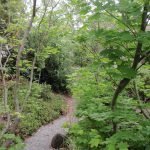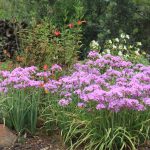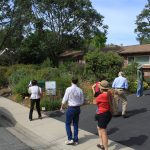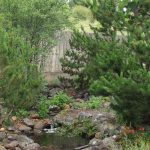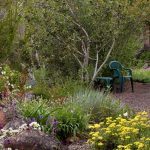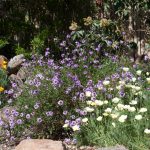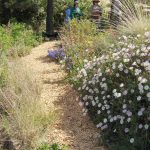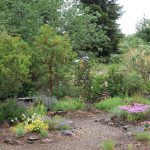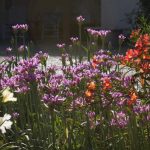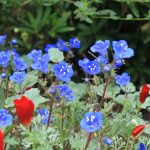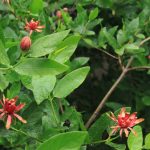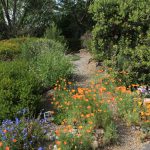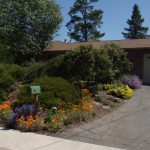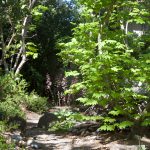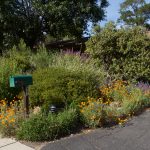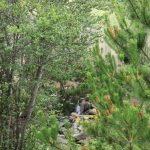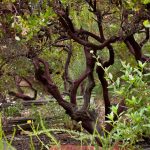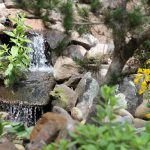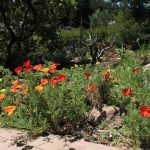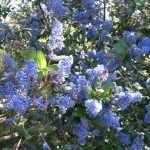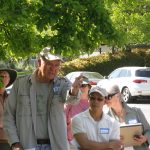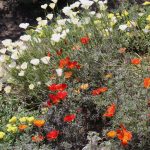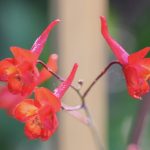Lot size: 8,500 square ft. lot, 95% native
Garden Age: This forty-five year old garden was planted in stages, beginning in the early 1970s
Years on the Bringing Back the Natives Garden Tour: 15
Showcase Feature
Over the last fifty years Al, a flyfishing author and teacher, converted his typical suburban lot into a lovely, low-maintenance, park-like landscape. In the beautiful front garden, a streambed located between graceful vine maples provides shaded riparian access to a walk-through chaparral area graced by mature manzanitas. In the back garden, trails wind through open areas of wildflowers that give way to tall shrubs and small trees such as shore pines, mountain mahogany, and madrone, and finally to tall conifers. A twenty-five foot long stream tumbles down through offset falls, a meander, and a shallow riffle and bird beach area before spilling into a fish and turtle pond.
- This spectacular garden contains over one hundred and seventy species of California natives. Most of the established plants receive no summer water.
- Japanese garden concepts have shaped the design of this yard.
- Mountain mahogany, pines, and toyons create an attractive, see-through canopy.
- Al, a professional fly fishing author and teacher, artfully designed one straight line in the back garden for his fly casting practice without detracting from the gently-curving natural look.
Bird baths and feeders, nesting houses, a shallow stream riffle, brush piles, dust bath areas, and abundant plant cover have attracted over ninety species of birds, including thrashers, tanagers, and black-throated gray warblers and eighteen species of native bees. Rock outcroppings, wood piles, and sandy areas add habitat for resident sharp-tailed snakes, and fence and alligator lizards. Recent plantings and landscape changes are attracting additional butterfly and native bee species.
Art in the Garden
Award-winning photographer Alan Krakauer will sell note cards and prints of vibrant natural landscapes, wildlife, and plants.
Lauri La Pointe will offer a large selection of gorgeous hand-crafted bead, Czech glass, button, lace, and Japanese washi paper earrings.
Garden Talks
11:00 and 12:00 “Gardening for native bees” by Elsa Zisook
2:00 “Al’s best tips from fifty years of planting and growing California natives: a sit-down discussion” by Al Kyte
Bird list
Strategy for Attracting Birds
Why Choose California Native Plants?
How I Got Started Gardening with Native Plants: Al Kyte’s story
California Native Plants for Moraga Gardens
Concepts That Guided My Landscaping
Strategies for Obtaining Plant and Garden Materials
California Native Plant Gardens-Shifting Perspectives
Creating Natural Looking Landscape (handout from talk)
California Native Plants: Strategies for Season-Long Bloom
How to Create a Natural-Looking Landscape
Lessons from Forty-five Years of Gardening with Natives Style in Gardening
A Native Plant Garden for Children, Animals and Adults
Videos of Al’s garden
Designing for Beauty—January and February
During January and February I consider changes for the next growing season, incorporating design elements such as sight lines, relationship between plants, composition and counterpoint. Manzanitas and currants are already kicking off the blooming season.
The Beauty of New Life—March and April
During March and April the garden comes to life with poppies and ceanothus leading a parade of colorful blooms. Pipeline swallowtail butterflies, native bees, and emerging lizards again become active.
The Beauty of Peak Bloom—May
Early May marks the time of peak bloom in the garden—our most complete range of vibrant color. Baby quail and other young animals and birds add to our pleasure.
The Beauty of Summertime—June, July, and August
During June, July and August additional plants come into bloom, extending the
wide range of colors of our garden into the warm, leisurely days of summer. This completes the year-long cycle of beauty in our California native plant garden.
The Dry Beauty at Summer’s End—September and October
During September and October my focus is on enhancing the beauty in the spaces between my plants in how I mulch, place rocks, and make pathways more natural.
Beauty Beyond the Bloom—November and December
During November and December my focus shifts to plant dimensions sometimes overlooked when blooms are abundant. I take notice of the color and texture of leaves, bark, and berries. Landscaping efforts include ways to retain soil and slow wa-ter runoff.
Al Kyte’s garden, 2020 (Zoom-quality video)


